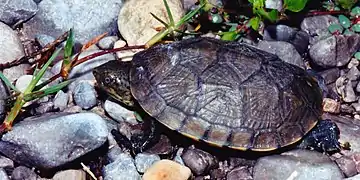Mexican mud turtle
Mexican mud turtle (Kinosternon integrum),[1] or Guanajuato mud turtle, is a species of mud turtle in the family Kinosternidae. Endemic to Mexico, it is found in Aguascalientes, Colima, Durango, Guanajuato, Guerrero, Hidalgo, Jalisco, Michoacán, México, Morelos, Nayarit, Oaxaca, Puebla, San Luis Potosí, Sinaloa, Sonora, Tamaulipas and Zacatecas, where they inhabit moist environments, such as shallow ponds, lakes, rivers or intermediate temp. tropical forest areas.
| Mexican mud turtle | |
|---|---|
 | |
| Mexican mud turtle (Kinosternon integrum), a sub-adult from the Municipality of Tula, Tamaulipas, Mexico (20 Sept 2003). | |
| Scientific classification | |
| Kingdom: | Animalia |
| Phylum: | Chordata |
| Class: | Reptilia |
| Order: | Testudines |
| Suborder: | Cryptodira |
| Family: | Kinosternidae |
| Genus: | Kinosternon |
| Species: | K. integrum |
| Binomial name | |
| Kinosternon integrum (Le Conte, 1854, 1925) | |
| Synonyms[2] | |
| |
Reproduction
The Mexican mud turtle's nesting season lasts from early May to September, beginning just prior to the summer rainy season.[3] A typical clutch size for each female is 2 to 4 eggs, but can range between 1 and 8.[4][5] Another distinctive feature within the species is the nostrils on male and female turtles. The females have a more rounded nostril and the nostril is more brownish as to yellow like the male. The Mexican mud turtle is an organism that "bet hedges" meaning that its organism fitness varies depending on the condition it is in. When in a relaxed, every-day state, its fitness levels are low, however when stressed its fitness level increases. Bet hedging affects this organism's reproductive window as well, allowing it to only reproduce every two to three seasons.[6]
References
- van Dijk, P.P.; Hammerson, G.; Vazquez Diaz, J.; Quintero Diaz, G.E.; Santos, G.; Flores-Villela, O. (2007). "Kinosternon integrum (errata version published in 2016)". IUCN Red List of Threatened Species. 2007: e.T63671A97381758. doi:10.2305/IUCN.UK.2007.RLTS.T63671A12705506.en. Retrieved 12 January 2020.{{cite iucn}}: error: |doi= / |page= mismatch (help)
- Fritz Uwe; Peter Havaš (2007). "Checklist of Chelonians of the World" (PDF). Vertebrate Zoology. 57 (2): 254. ISSN 1864-5755. Archived from the original (PDF) on 17 December 2010. Retrieved 29 May 2012.
- Iverson, John B. (1999). "Reproduction in the Mexican Mud Turtle Kinosternon integrum". Journal of Herpetology. 33 (1): 144–148. doi:10.2307/1565557. ISSN 0022-1511. JSTOR 1565557.
- Casas-Andreu, Gustavo; Aguilar-Miguel, Xochitl S.; Cisneros, Maria de Lourdes Arias; Macip-Ríos, Rodrigo (December 2009). "Population Ecology and Reproduction of the Mexican Mud Turtle (Kinosternon integrum) in Tonatico, Estado de México". Western North American Naturalist. 69 (4): 501–510. doi:10.3398/064.069.0410. ISSN 1527-0904. S2CID 59423562.
- Sustaita-Rodríguez, Víctor Hugo; Arias-Cisneros, María de Lourdes; Casas-Andreu, Gustavo; Brauer-Robleda, Pablo; Macip-Ríos, Rodrigo (January 2012). "Evidence for the Morphological Constraint Hypothesis and Optimal Offspring Size Theory in the Mexican Mud Turtle (Kinosternon integrum)". Zoological Science. 29 (1): 60–65. doi:10.2108/zsj.29.60. ISSN 0289-0003. PMID 22233498. S2CID 15192149.
- Macip-Ríos, Rodrigo; Cisneros, Maria de Lourdes Arias; Aguilar-Miguel, Xochitl S.; Casas-Andreu, Gustavo (December 2009). "Population Ecology and Reproduction of the Mexican Mud Turtle (Kinosternon integrum) in Tonatico, Estado de México". Western North American Naturalist. 69 (4): 501–510. doi:10.3398/064.069.0410. ISSN 1527-0904. S2CID 59423562.
Sources
- Le Conte, 1854: "Description of four new species of Kinosternum". Proceedings of the Academy of Natural Sciences of Philadelphia. 7: 180–190.
- Iverson, John B. (1999). "Reproduction in the Mexican Mud Turtle Kinosternon integrum". Journal of Herpetology. 33 (1): 144–148. doi:10.2307/1565557. JSTOR 1565557.
- Macip-Ríos, Rodrigo; Cisneros, Maria de Lourdes Arias; Aguilar-Miguel, Xochitl S.; Casas-Andreu, Gustavo (2009). "Population Ecology and Reproduction of the Mexican Mud Turtle (Kinosternon integrum) in Tonatico, Estado de México". Western North American Naturalist. 69 (4): 501–510. doi:10.3398/064.069.0410. S2CID 59423562.
- Aparicio, Ángeles; Mercado, Ivette Enríquez; Ugalde, Alejandro Montiel; Gaona-Murillo, Eder; Butterfield, Taggert; Macip-Ríos, Rodrigo (2018). "Ecological Observations of the Mexican Mud Turtle (Kinosternon integrum) in the Pátzcuaro Basin, Michoacán, México". Chelonian Conservation and Biology. 17 (2): 284. doi:10.2744/CCB-1305.1. S2CID 92499132.
- Macip-Ríos, Rodrigo; Sustaita-Rodríguez, Víctor Hugo; Barrios-Quiroz, Gabriel; Casas-Andreu, Gustavo (2010). "Alimentary Habits of the Mexican Mud Turtle (Kinosternon integrum) in Tonatico, Estado de México". Chelonian Conservation and Biology. 9: 90–97. doi:10.2744/CCB-0782.1. S2CID 85867435.
- Macip-Ríos, Rodrigo & Zuñiga Vega, Jaime & Brauer Robleda, Pablo & Casas-Andreu, Gustavo (2011). "Demography of two populations of the Mexican mud turtle (Kinosternon integrum) in central Mexico". Herpetological Journal. 21.
